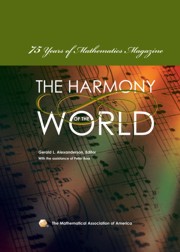Book contents
- Frontmatter
- Introduction
- Contents
- A Brief History of Mathematics Magazine
- Part I The First Fifteen Years
- Perfect Numbers
- Rejected Papers of Three Famous Mathematicians
- Review of Men of Mathematics
- Oslo under the Integral Sign
- Vigeland's Monument to Abel in Oslo
- The History of Mathematics
- Numerical Notations and Their Influence on Mathematics
- Part II The 1940s
- Part III The 1950s
- Part IV The 1960s
- Part V The 1970s
- Part VI The 1980s
- Briefly Noted
- The Problem Section
- Index
- About the Editors
Numerical Notations and Their Influence on Mathematics
from Part I - The First Fifteen Years
- Frontmatter
- Introduction
- Contents
- A Brief History of Mathematics Magazine
- Part I The First Fifteen Years
- Perfect Numbers
- Rejected Papers of Three Famous Mathematicians
- Review of Men of Mathematics
- Oslo under the Integral Sign
- Vigeland's Monument to Abel in Oslo
- The History of Mathematics
- Numerical Notations and Their Influence on Mathematics
- Part II The 1940s
- Part III The 1950s
- Part IV The 1960s
- Part V The 1970s
- Part VI The 1980s
- Briefly Noted
- The Problem Section
- Index
- About the Editors
Summary
Editor's Note: Derrick Henry Lehmer was a distinguished number theorist at the University of California, Berkeley, where his father, Derrick Norman Lehmer, had also been a number theorist known for his pioneering use of computing devices in the field, though to call them computers would be an exaggeration by modern standards. Two of the elder Lehmer's publications were Factor Table for the First Ten Millions Containing the Smallest Factor of Every Number Not Divisible by 2, 3, 5, or 7 between the Limits 0 and 10,017,000 (1956) and List of Prime Numbers from 1 to 10,006,721 (1956). D. H. Lehmer's wife, Emma Lehmer, is also widely known as a number theorist and the three Lehmers shared a common interest in computation as an aid to doing number theory. D. H. Lehmer's name is forever attached to the Lucas-Lehmer primality test which remains the means of finding larger and larger Mersenne primes, a search that still goes on.
Derrick H. Lehmer graduated from Berkeley and went on to work with L. E. Dickson at the University of Chicago before transferring to Brown University to complete his PhD there under J. D. Tamarkin. He returned to teach at Berkeley after postdoctoral appointments at the California Institute of Technology, Stanford University and a longer appointment at Lehigh. This article on mathematical notation was written while he was at Stanford.
- Type
- Chapter
- Information
- Harmony of the World75 Years of Mathematics Magazine, pp. 29 - 32Publisher: Mathematical Association of AmericaPrint publication year: 2007

